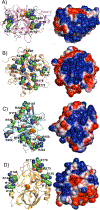Sulfated Non-Saccharide Glycosaminoglycan Mimetics as Novel Drug Discovery Platform for Various Pathologies
- PMID: 30457046
- PMCID: PMC6551317
- DOI: 10.2174/0929867325666181120101147
Sulfated Non-Saccharide Glycosaminoglycan Mimetics as Novel Drug Discovery Platform for Various Pathologies
Abstract
Glycosaminoglycans (GAGs) are very complex, natural anionic polysaccharides. They are polymers of repeating disaccharide units of uronic acid and hexosamine residues. Owing to their template-free, spatiotemporally-controlled, and enzyme-mediated biosyntheses, GAGs possess enormous polydispersity, heterogeneity, and structural diversity which often translate into multiple biological roles. It is well documented that GAGs contribute to physiological and pathological processes by binding to proteins including serine proteases, serpins, chemokines, growth factors, and microbial proteins. Despite advances in the GAG field, the GAG-protein interface remains largely unexploited by drug discovery programs. Thus, Non-Saccharide Glycosaminoglycan Mimetics (NSGMs) have been rationally developed as a novel class of sulfated molecules that modulate GAG-protein interface to promote various biological outcomes of substantial benefit to human health. In this review, we describe the chemical, biochemical, and pharmacological aspects of recently reported NSGMs and highlight their therapeutic potentials as structurally and mechanistically novel anti-coagulants, anti-cancer agents, anti-emphysema agents, and anti-viral agents. We also describe the challenges that complicate their advancement and describe ongoing efforts to overcome these challenges with the aim of advancing the novel platform of NSGMs to clinical use.
Keywords: Glycosaminoglycans; anticancer; anticoagulants; antivirals; non-saccharide glycosaminoglycan mimetics; sulfated molecules..
Copyright© Bentham Science Publishers; For any queries, please email at epub@benthamscience.net.
Conflict of interest statement
CONFLICT OF INTEREST
Authors declare no competing financial conflict of interest.
Figures













Similar articles
-
A molecular dynamics-based algorithm for evaluating the glycosaminoglycan mimicking potential of synthetic, homogenous, sulfated small molecules.PLoS One. 2017 Feb 9;12(2):e0171619. doi: 10.1371/journal.pone.0171619. eCollection 2017. PLoS One. 2017. PMID: 28182755 Free PMC article.
-
Allosteric Inhibition of Factor XIIIa. Non-Saccharide Glycosaminoglycan Mimetics, but Not Glycosaminoglycans, Exhibit Promising Inhibition Profile.PLoS One. 2016 Jul 28;11(7):e0160189. doi: 10.1371/journal.pone.0160189. eCollection 2016. PLoS One. 2016. PMID: 27467511 Free PMC article.
-
Synthesis of glycosaminoglycan mimetics through sulfation of polyphenols.Methods Mol Biol. 2015;1229:49-67. doi: 10.1007/978-1-4939-1714-3_7. Methods Mol Biol. 2015. PMID: 25325944
-
Glycosaminoglycans (GAGs) and GAG mimetics regulate the behavior of stem cell differentiation.Colloids Surf B Biointerfaces. 2017 Feb 1;150:175-182. doi: 10.1016/j.colsurfb.2016.11.022. Epub 2016 Nov 20. Colloids Surf B Biointerfaces. 2017. PMID: 27914254 Review.
-
Glycosaminoglycans and Glycosaminoglycan Mimetics in Cancer and Inflammation.Int J Mol Sci. 2019 Apr 22;20(8):1963. doi: 10.3390/ijms20081963. Int J Mol Sci. 2019. PMID: 31013618 Free PMC article. Review.
Cited by
-
From Cancer to COVID-19: A Perspective on Targeting Heparan Sulfate-Protein Interactions.Chem Rec. 2021 Nov;21(11):3087-3101. doi: 10.1002/tcr.202100125. Epub 2021 Jun 19. Chem Rec. 2021. PMID: 34145723 Free PMC article. Review.
-
Heparin, Heparin-like Molecules, and Heparin Mimetics in Breast Cancer: A Concise Review.Biomolecules. 2025 Jul 17;15(7):1034. doi: 10.3390/biom15071034. Biomolecules. 2025. PMID: 40723905 Free PMC article. Review.
-
Polymers Inspired by Heparin and Heparan Sulfate for Viral Targeting.Macromolecules. 2022 Sep 27;55(18):7957-7973. doi: 10.1021/acs.macromol.2c00675. Epub 2022 Sep 11. Macromolecules. 2022. PMID: 36186574 Free PMC article. Review.
-
On the Selectivity of Heparan Sulfate Recognition by SARS-CoV-2 Spike Glycoprotein.ACS Med Chem Lett. 2021 Oct 8;12(11):1710-1717. doi: 10.1021/acsmedchemlett.1c00343. eCollection 2021 Nov 11. ACS Med Chem Lett. 2021. PMID: 34786180 Free PMC article.
-
Homogeneous, Synthetic, Non-Saccharide Glycosaminoglycan Mimetics as Potent Inhibitors of Human Cathepsin G.Biomolecules. 2023 Apr 27;13(5):760. doi: 10.3390/biom13050760. Biomolecules. 2023. PMID: 37238630 Free PMC article.
References
-
- Gandhi NS; Mancera RL The structure of glycosaminoglycans and their interactions with proteins. Chem. Biol. Drug Des, 2008, 72, 455–482. - PubMed
-
- Esko JD; Kimata K; Lindahl U Proteoglycans and Sulfated Glycosaminoglycans, In: Essentials of Glycobiology; Varki Ajit, Executive Editor, Cummings Richard D, Esko Jeffrey D, Stanley Pamela, Hart Gerald W, Aebi Markus, Darvill Alan G, Kinoshita Taroh, Packer Nicolle H, Prestegard James H, Schnaar Ronald L, and Seeberger Peter H., Ed.; Cold Spring Harbor (NY): Cold Spring Harbor Laboratory Press, 2009; pp. 784. - PubMed
-
- Imberty A; Lortat-Jacob H; Pérez S Structural view of glycosaminoglycan-protein interactions. Carbohydr. Res, 2007, 342, 430–439. - PubMed
-
- Sasisekharan R; Venkataraman G Heparin and heparan sulfate: Biosynthesis, structure and function. Curr. Opin. Chem. Biol, 2000, 4, 626–631. - PubMed
Publication types
MeSH terms
Substances
Grants and funding
LinkOut - more resources
Full Text Sources

